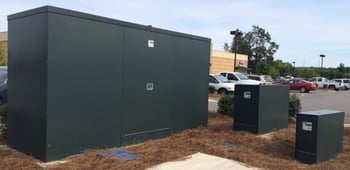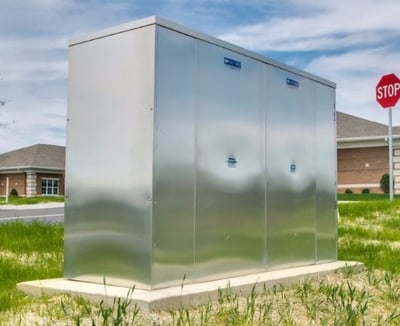
Each spring your local water authority sends their annual notice to have your backflow preventer tested for recertification. Why not take this time for annual preventive maintenance tasks to the aluminum enclosure, too?
Keeping your system and enclosure in good working order will help you prevent costly repairs in the future. After all, the backflow preventer is the most important valve in the water system. Its sole purpose is to protect water, our most precious natural resource.
That means the backflow enclosure is also essential to protecting the water supply, as its primary job is to protect the valves that protect the water. It’s the water industry version of the circle of life.
So this spring, as you get your backflow preventers re-certified, think about the renewal and proper maintenance of your backflow enclosure to spot potential issues and avoid costly emergency repairs.
Your Spring Maintenance Checklist
Here are four critical items to check that are located in and around your aluminum enclosure. With proper maintenance, aluminum is quite durable and your equipment will stay in good working condition.
1. Check the Enclosure’s Exterior
An important first step on the preventive maintenance checklist is to inspect the area around the enclosure for landscape debris, plant growth and overhanging limbs that might eventually damage the enclosure. Aim for three feet of clearance between the enclosure and all landscaping. Remove landscaping as necessary to keep the enclosure free and clear.
Now might be the time to swap out plants if they’re overgrown or unable to be neatly trimmed since outdoor environments can be unpredictable . Opt for low-maintenance plants that provide sufficient coverage but won’t impede necessary access for maintenance or testing.
Make sure the doors and openings designed for relief valve discharge are not blocked or hindered from operating correctly. These openings are crucial to properly protecting your backflow preventers, meters, valves and pump systems.
Give the enclosure a once over for graffiti or excess dirt. Graffiti removers depend on the finish of your enclosure. Use aircraft paint remover for mill finish and mild detergent for colored coatings. Test both in a small area first to prevent damaging the finish.
Check that the caulk bead along the bottom of all panels (except access panels and doors) is still intact. It may crack or dry out and needs to be replaced to ensure the enclosure maintains appropriate temperature in the winter.
Assess any exterior damage. Damage can be commonly caused by cars crashing into the structure or tree limbs falling on top. The beauty of a modular design — like Safe-T-Cover’s enclosures — means you can call the manufacturer with the structure’s serial number. A new replacement panel will be made and sent for a small fee to help you save money on a whole enclosure redo.
2. Check the Thermostat
Upon entering the enclosure, first check that the thermostat is working properly and any cooling systems are operating safely. Check the manufacturer's troubleshooting guide to maintain proper thermostat operation.
Make sure the thermostat is set to 40 degrees Fahrenheit to meet ASSE 1060 certifications.
3. Check the Heating Element
Next up on the preventive maintenance checklist is to check the heating element. For small diameter installations, make sure the heat trace is still properly installed and no sections are showing exposure or weathering.
For wall-mounted heaters, confirm that they’re still mounted correctly and haven’t shorted out due to extensive relief valve discharge.
For slab-mounted heaters, verify that the element is free of any debris. Since these heaters are wet/damp certified, you don’t need to worry about water conditions or relief valve discharge.
If your enclosure is installed in a traditionally warm weather climate, and no heating element is currently installed, consider adding a thermostat and heater to your enclosure. Recent years have seen freezing conditions in Houston, Texas and Miami, Florida; anywhere in the United States is now susceptible to catastrophic freezing conditions.
4. Check the Interior
Thoroughly inspect the insulation inside the enclosure. Some manufacturers use stick-on or spray-in insulation that deteriorates and detaches over time. If the insulation is compromised, the enclosure loses effectiveness. Spot potential problems now so you don't pay for it later.
Test the interior for structural damage and general wear and tear. Fiberglass enclosures are easily damaged from wind and weather and will deteriorate over time. If weaknesses have developed, it's time to upgrade to a marine-grade aluminum enclosure. Read more about clamshell fiberglass vs. aluminum covers here.
Maintenance Tasks, Complete!
Whether your water authority requires the recertification of your backflow preventer or not, it’s important to test your backflow each year to ensure the water supply is properly protected. This maintenance checklist makes it easy to check your backflow enclosure at the same time. If you notice that your enclosure is worse for wear, it might be time to replace.
Upgrade to a Safe-T-Cover Aluminum Enclosure
Our enclosures are built to last without the risk of rotting or material deterioration. Even with a colored enclosure, there’s no need for frequent repainting since the color application is designed for long-term durability.
We make every component to withstand the test of time, ensuring reliable protection for your equipment. Some of our enclosures have been in the field for 30 years! With simple annual checks from this maintenance checklist, you can count on consistent performance without constant upkeep.





